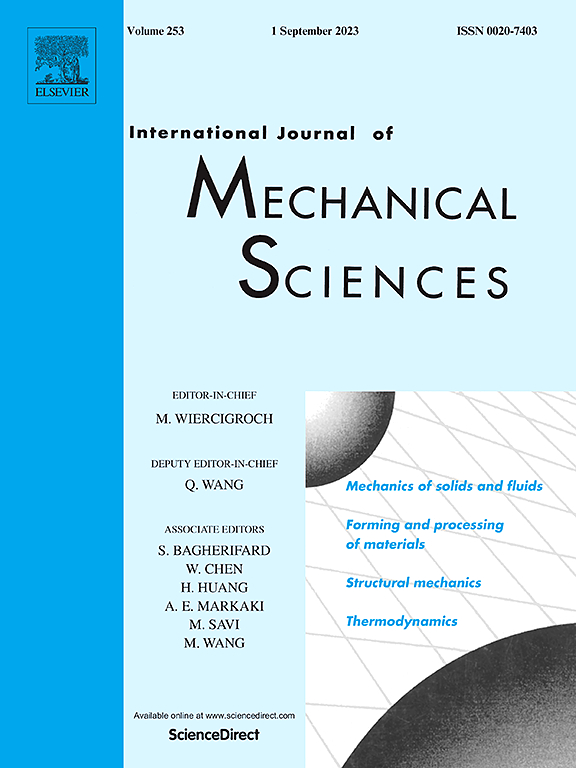纳米晶镍基高温合金的塑性变形与纳米切削特性
IF 9.4
1区 工程技术
Q1 ENGINEERING, MECHANICAL
International Journal of Mechanical Sciences
Pub Date : 2025-06-08
DOI:10.1016/j.ijmecsci.2025.110483
引用次数: 0
摘要
采用分子动力学方法模拟纳米切削纳米晶镍基高温合金(NCNBS)的接触诱发塑性变形及其力学特性。结果表明,单晶工件的变形主要由位错滑移控制,而纳米晶工件的变形则是多种机制协同作用的结果:(1)晶界(GB)滑动和迁移,(2)晶界扩展和解理开裂,(3)三结迁移和旋转,(4)晶粒旋转和合并,(5)晶粒粗化,(6)源自加工表面和晶界的层错和变形孪晶形核和扩展。晶粒细化引起的反向Hall-Petch效应显著降低了表面粗糙度(- 14.05%)、推力(- 17.27%)和平均位错线长度(- 14.36%);摩擦系数增加了14.29%。此外,表面粗糙度、切削力和摩擦系数与切削速度和深度有很强的相关性。应力和应变主要沿着GBs传播,但这些GBs有效地抑制了应力和应变沿晶粒内部原始路径的传播。升高的切削参数(晶粒数、切削速度和切削深度)放大了高应力和高应变的值和影响区域。HCP生成速率随切削速度的增加而降低,表明切削速度对位错形核和扩展有明显的抑制作用。这些发现阐明了NCNBS中原子尺度的材料去除机制,并为超精密部件制造中的设计优化和参数选择建立了创新框架。本文章由计算机程序翻译,如有差异,请以英文原文为准。

Plastic deformation and nano-cutting characteristics of nanocrystalline Ni-based superalloy
Molecular dynamics simulations of nano-cutting nanocrystalline Ni-based superalloy (NCNBS) were performed to investigate contact-induced plastic deformation and the mechanical characteristics. The results indicate that deformation in single crystalline workpieces is predominantly governed by dislocation slip, whereas deformation in nanocrystalline workpieces is attributed to the synergistic action of multiple mechanisms: (1) grain boundary (GB) sliding and migration, (2) GB expansion and cleavage cracking, (3) triple junction migration and rotation, (4) grain rotation and merging, (5) grain coarsening, and (6) nucleation and expansion of stacking faults and deformation twins originating at the machining surface and GBs. The grain refinement-induced reverse Hall-Petch effect results in significant reductions in surface roughness (−14.05%), thrust force (−17.27%), and average dislocation line length (−14.36%); however, it increases the friction coefficient by 14.29%. Furthermore, surface roughness, cutting forces, and friction coefficients exhibit strong correlations with cutting velocities and depths. Stress and strain primarily propagate along GBs, yet these GBs effectively inhibit their transmission along the original paths within grain interiors. Elevated cutting parameters (grain number, cutting velocity, and cutting depth) amplify both the values and affected areas of high stress and strain. The HCP generation rates decrease in lockstep with the cutting velocity, indicating velocity’s marked suppression of dislocation nucleation and expansion. These findings elucidate the atomic-scale material removal mechanisms in NCNBS and establish innovative frameworks for design optimization and parameter selection in ultra-precision component manufacturing.
求助全文
通过发布文献求助,成功后即可免费获取论文全文。
去求助
来源期刊

International Journal of Mechanical Sciences
工程技术-工程:机械
CiteScore
12.80
自引率
17.80%
发文量
769
审稿时长
19 days
期刊介绍:
The International Journal of Mechanical Sciences (IJMS) serves as a global platform for the publication and dissemination of original research that contributes to a deeper scientific understanding of the fundamental disciplines within mechanical, civil, and material engineering.
The primary focus of IJMS is to showcase innovative and ground-breaking work that utilizes analytical and computational modeling techniques, such as Finite Element Method (FEM), Boundary Element Method (BEM), and mesh-free methods, among others. These modeling methods are applied to diverse fields including rigid-body mechanics (e.g., dynamics, vibration, stability), structural mechanics, metal forming, advanced materials (e.g., metals, composites, cellular, smart) behavior and applications, impact mechanics, strain localization, and other nonlinear effects (e.g., large deflections, plasticity, fracture).
Additionally, IJMS covers the realms of fluid mechanics (both external and internal flows), tribology, thermodynamics, and materials processing. These subjects collectively form the core of the journal's content.
In summary, IJMS provides a prestigious platform for researchers to present their original contributions, shedding light on analytical and computational modeling methods in various areas of mechanical engineering, as well as exploring the behavior and application of advanced materials, fluid mechanics, thermodynamics, and materials processing.
 求助内容:
求助内容: 应助结果提醒方式:
应助结果提醒方式:


